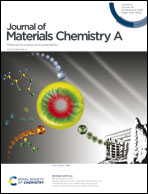Direct observation of continuous networks of ‘sol–gel’ processed metal oxide thin film for organic and perovskite photovoltaic modules with long-term stability†
Abstract
‘Sol–gel’-processed transition metal oxide (TMO) thin films sandwiched by an organic photoactive layer and metal electrodes have proven to be a versatile interlayer for photovoltaics with long-term stability on the laboratory scale; however, chemical defects and dewetting (or shrinkage) processes during sol–gel synthesis on top of the photoactive layer often cause performance variations, impeding the development of large-area photovoltaic modules. Here, we demonstrate that a low surface energy difference at the organic interface allows long-range diffusion of metal ion precursors to promote continuous chemical synthesis associated with oxo-bridge formation. Using high-resolution Auger electron spectroscopy, we confirm that the resultant TMO thin film on top of the suitable surface has a defect-free and continuous metal–oxygen network (MON) with a high oxygen/metal ratio. Our findings can be applied to obtain organic/perovskite photovoltaic modules having long-term stability, approaching an efficiency of 4.2%/14.5% and maintaining over 80% of their initial efficiency for up to 1500 hours/2000 hours with an area of 10.8 cm2/9.06 cm2.



 Please wait while we load your content...
Please wait while we load your content...